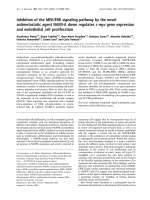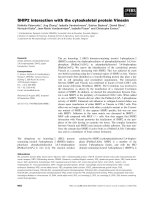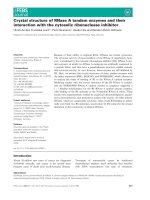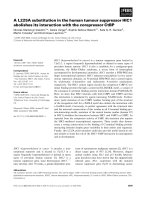S100A4 suppresses cancer stem cell proliferation via interaction with the IKK/NF-κB signaling pathway
Bạn đang xem bản rút gọn của tài liệu. Xem và tải ngay bản đầy đủ của tài liệu tại đây (1.25 MB, 7 trang )
Zhu et al. BMC Cancer (2018) 18:763
/>
RESEARCH ARTICLE
Open Access
S100A4 suppresses cancer stem cell
proliferation via interaction with the
IKK/NF-κB signaling pathway
Yongtong Zhu1† , Yao Zhou1†, Xuan Zhou1, Yangchun Guo1, Daxiong Huang1, Jialin Zhang1, Chunyan Wang2*
and Longmei Cai3*
Abstract
Background: Bladder cancer often recurs due to incomplete elimination of the cancer stem cells (CSCs). Therefore,
new strategies targeting bladder CSCs are needed and the aim of this study was to investigate the effect of S100A4
on the proliferation capacity of MB49 bladder cancer stem cells (MCSCs).
Methods: MCSCs were established and validated. The expression level of S100A4 in MCSCs and MB49 cells was
evaluated using Western blotting and quantitative polymerase chain reaction (QPCR). S100A4 was overexpressed or
knocked-down by transfection of pCMV6-XL5-S100A4 plasmid or RNA interference (RNAi) respectively. Proliferation
capacity of MCSC was evaluated by cell proliferation assay and in vivo tumorigenicity study. Transcriptional activity
of nuclear factor kappa B (NF-κB) was analyzed using luciferase reporter assay, and the level of interleukin (IL)-2 as
well as tumor necrosis factor (TNF) was quantified by QPCR. Protein-protein interaction of S100A4 and inhibitor of
nuclear factor kappa B NF-κB kinase (IKK) was analyzed by immunoprecipitation.
Results: S100A4 was significantly up-regulated in MCSCs, which positively associated with the proliferation capacity,
as well as the level of NF-κB, IKK, IL-2 and TNF in MCSCs. Knock-down of S100A4 could reverse such effects. Using
immunoprecipitation assay, an interaction between S100A4 and IKK could be observed.
Conclusions: S100A4 is upregulated in MCSCs and possibly enhance the proliferation ability of MCSCs by way of
activating the IKK/NF-κB signaling pathway, and S100A4 maybe a hopeful therapeutic target for MCSCs.
Keywords: S100A4, Cancer stem cells, Proliferation, IKK, NF-κB
Background
Bladder cancer is a most common urological cancer in
China, and the rest of the world [1]. Radical cystectomy
with pelvic lymphadenectomy is the standard treatment
for bladder cancer. However, bladder cancer may recur
due to the incomplete elimination of cancer stem cells
(CSCs). Therefore, new strategies targeting bladder CSCs
are urgently needed.
S100A4, also known as metastasin/FSP1/pEL98/mts-1,
is a gene encoding a small calcium binding protein that
* Correspondence: ;
†
Yongtong Zhu and Yao Zhou contributed equally to this work.
2
Department of Neurology, Integrated Hospital of Traditional Chinese
Medicine, Southern Medical University, Guangzhou 510315, China
3
Department of Radiation Oncology, Nanfang Hospital, Southern Medical
University, Guangzhou 510515, China
Full list of author information is available at the end of the article
interacts with other proteins to enhance apoptosis, cell
motility, and tumorigenesis [2]. S100A4 is overexpressed
in most cancers, including breast cancer, gastric cancer,
and non-small cell lung cancer (NSCLC) [3]. In addition,
S100A4 expression is correlated with patients’ outcome
and cancer metastasis [4]. It has been recently reported
that S100A4 is a novel marker and a critical regulator of
glioma stem cells, with the enhanced S100A4 expression
contributing to the presentation of a metastatic phenotype [5]. These findings indicate that S100A4 may be a
promising therapeutic target for bladder CSCs. Through
bioinformatics analysis in preliminary experiments, we
found that there was a close relationship between
S100A4 protein and the nuclear factor kappa B (NF-κB)
signaling pathway.
© The Author(s). 2018 Open Access This article is distributed under the terms of the Creative Commons Attribution 4.0
International License ( which permits unrestricted use, distribution, and
reproduction in any medium, provided you give appropriate credit to the original author(s) and the source, provide a link to
the Creative Commons license, and indicate if changes were made. The Creative Commons Public Domain Dedication waiver
( applies to the data made available in this article, unless otherwise stated.
Zhu et al. BMC Cancer (2018) 18:763
Page 2 of 7
In the present study, we demonstrate that S100A4 is
up-regulated in MB49 bladder cancer stem cells
(MCSCs). Additionally, overexpression of S100A4 enhances the proliferation capacity of MCSCs in vitro, and
also upregulates inhibitor of nuclear factor kappa B
NF-κB kinase (IKK) and activates the NF-κBsignaling
pathway, whereas knockdown of S100A4 resulted in the
opposite effects. The findings of this study suggest that
S100A4 may promote the proliferation capacity and upregulate IKK in MCSCs by activating the NF-κB signaling pathway. Therefore, S100A4 may have the potential
to be a therapeutic target in MCSCs.
Methods
Establishment and characterizations of MCSCs
MCSCs were obtained from MB49 bladder cancer cells,
which was a mouse cell line, using limited dilution and
serum-free culture medium method described previously
[6]. The serum-free culture medium was consisted of
RPMI1640 supplemented with leukemia inhibitory factor
(20 ng/ml, eBioscience, San Diego, CA), basic fibroblast
growth factor (20 ng/ml, Peprotech, Rocky Hill, NJ), epidermal growth factor (20 ng/ml, Peprotech), bovine
serum albumin (4 μg/ml, Thermo Scientific HyClone,
Logan, UT), and B-27 serum-free supplement (20 μl/ml,
Invitrogen, Grand Island, NY).
The validation of MCSCs was performed as previously
reported [6]. Cancer stem cell markers CD133 and
CD44 was detected by flow cytometry analysis, Western
blotting, and quantitative polymerase chain reaction
(QPCR). The proliferative ability and susceptibility to
chemotherapy were examined by Cell Counting Kit-8 reagent assay. Cell migration ability was examined with
the transwell assay. The tumorigenic ability was verified
using nude mice.
Western blot analysis
The MB49 cells and MCSCs were respectively harvested.
Equal amount proteins were extracted from cells, and
separated by 10% sodium dodecyl sulfate -polyacrylamide gel electrophoresis followed by transferring to
polyvinylidene difluoride membranes (Millipore, Billerica, MA). The membranes were blocked with 5% skim
milk in PBS, and incubated overnight at 4 °C with the
primary antibodies including anti-S100A4 (Abcam,
Cambridge, MA), anti- IKK (Abcam) and anti-β-actin
antibody (Abcam) followed by secondary antibodies
(Abcam). Bands were visualized using Fluor Chem FC2
(Alpha Innotech, San Leandro, CA).
Quantitative polymerase chain reaction
Total RNA was extracted using the Arcturus PicoPure
RNA isolation kit (Applied Biosciences, Carlsbad, NM).
RNA quality was tested using the Bioanalyzer RNA Pico
Chip (Agilent Technologies, Santa Clara, CA). Total
RNA were transcribed reversely with Superscript III
(Invitrogen), followed by synthesizing the first-strand
cDNA which was amplified using a SYBR green PCR
master mix (Bio-Rad, Hercules, CA) performed on a 7500
real-time PCR system (AB Applied Biosystems,
Singapore). The cycling systems were denaturation (95 °C
for 10 s), annealing and extension (60 °C for 60 s). The
primers were designed using Primer Express version 2.0
(Applied Biosystems, Foster City, CA), and are shown
in Table 1. The relative expression level were analyzed
using the ΔΔCt method. GAPDH was used as the internal control.
Plasmid construction, and RNA interference and
transfection
Full length of S100A4 gene were inserted into a vector
plasmid pCMV6-XL5 (OriGene Technologies). MCSC
cells were transfected with pCMV6-XL5-S100A4 plasmid (pCMV-S100A4) performing in Lipofectamine™
2000 (Invitrogen) following the manufacturer’s instructions, which were referred to as MCSCs/S100A4-vector.
The expression of S100A4 was detected at 48 and 72 h
after transfection on transcription and translation level
respectively.
S100A4 was knockdown by S100A4-siRNA transfection. Double-stranded siRNAs specific to S100A4 were
bought from Shanghai GenePharma Co., Ltd. (Shanghai,
Table 1 Primers of selected genes
Gene name
Primers (forward/reverse)
Base pairs of product
S100A4
F: 5’- CCCTGGATGTGATGGTGT-3’
615 bp
R: 5’- GTTGTCCCTGTTGCTGTC-3’
Interleukin (IL)-2
F: 5’- GAATGGAATTAATAATTACAAGAA-3’
401 bp
R; 5’-TGTTTCAGATCCCTTTAGTTCCAG-3’
Tumor necrosis factor (TNF)
F: 5’- CCAGGCAGTCAGATCATCTTCTC-3’
179 bp
R: 5’- AGCTGGTTATCTCTCAGCTCCAC-3’
GAPDH
F: 5’-CCATGGAGAAGGCTGGGG-3’
R: 5’-CAAAGTTGTCATCCATGAC-3’
198 bp
Zhu et al. BMC Cancer (2018) 18:763
China). The S100A4 siRNA sequences were 5’-TGTA
ACGAATTCTTTGAAG-3′,
and
5’-ACGAATTCT
TTGAAGGCTT-3′. The non-coding (NC) siRNAs sequence was 5’-UUCUCCGAACGUGUCACGUTT-3′.
MCSCs were transfected with a final concentration of
20 nM of siRNA performing in Lipofectamine™ 2000,
which were referred to as MCSCs/S100A4-siRNA or
MCSCs/NC-siRNA cells, respectively.
Cell counting Kit-8 (CCK-8) assay
Cells were plated at a density of 1 × 103 cells per well in
a 96-well plate, followed by incubating for 72 h. After incubation, cell counting kit-8 reagent (CCK-8, Dojindo
Molecular Technologies, Kumamoto, Japan) was added
to each well with 10 μl at a time periods of 24, 48, and
72 h. Incubated for 4 h, the absorbance value was read
at 450 nm performing in EnSpire 2300 multilabel reader
(PerkinElmer, Singapore).
Page 3 of 7
and 4-(2-aminoethyl) benzenesulfonyl fluoride hydrochloride, and 10 mM iodoacetate. After incubation,
cellular debris and nuclei were removed by centrifugation. Cell lysates were incubated with specific antibody overnight, and then with Protein A-Sepharose
(Amersham Biosciences, Piscataway, NJ) beads for another 4 h. The immunoprecipitates were washed in
Tris-buffered saline four times and boiled in Laemmli
buffer included of 0.02% blue bromophenol and 2%
bmercaptoethanol.
Statistical analysis
SPSS19.0 software was used for all statistical analyses.
Numeric data were described as the mean value ± standard deviation. Comparisons were performed by Students
t-test. A value of P < 0.05 was considered to indicate statistical significance.
In vivo tumorigenicity study
Results
All animal experiments were obeyed the Chinese animal
protection laws and guidelines, and approved by the
Ethics Committee of Southern Medical University
(Contract 1,116,904).
Four-week-old immune deficient nude mice were purchased from Experimental Animals Center (Southern
Medical University, Guangzhou, China), and fed under
specific, pathogen-free conditions. Cells (1 × 104) were
injected into mice subcutaneously. Tumor xenograft
formation was recorded at 10, 20, 30, and 45 days,
calculated the tumor volume according to the formula
d2 × D/2, where D and d were the longest and the shortest diameters, respectively. Then mice were sacrificed
after CO2 anesthesia.
Expression of S100A4 in MCSC MB49 cells
S100A4 level in MCSCs was increased as detected by
Western blotting (Fig. 1a), and S100A4 mRNA expression level in MCSCs was also significantly increased as
detected by QPCR (Fig. 1b).
Luciferase reporter assay
NF-κB transcriptional activity was examined using the
pNF-κB-luciferase reporter and control plasmids
(Clontech, Mountain View, CA). The cells were plated
at a sub confluent density, followed by co-transfecting
with 0.5 μg of NF-κB luciferase reporter plasmid or
negative plasmid, and 0.02 μg of Renilla luciferase
pRL-TK plasmid (Promega, Madison, WI) performing in
Lipofectamine 2000 reagent (Invitrogen). Cell lysates
were prepared 24 h after transfection, and the reporter
activity was measured using the Dual-luciferase reporter
assay system (Promega).
Immunoprecipitation
Cells were washed with ice-cold PBS, followed by
lysing in Tris-buffered saline (pH 7.4), containing
150 mM NaCl, 50 mM Tris, 0.1% Nonidet P-40,
1 mM EDTA, 1 mM Na3VO4, 10 mM NaF, 2.5 mg/
ml aprotinin and leupeptin, 1 mM β-glycerophosphate
Fig. 1 S100A4 was upregulated in MCSCs. a Western blotting
analysis of S100A4 protein expression in MCSCs and MB49 cells;
β-actin was used as a loading control. b Quantitative PCR of S100A4
mRNA expression in MCSCs and MB49 cells. Transcript levels were
normalized to GAPDH, and expressed relative to MB49 cells. Data is
mean ± SD of three independent experiments. *P < 0.05
Zhu et al. BMC Cancer (2018) 18:763
Effects of transfection on MCSCs
MCSCs were transfected with S100A4-vector or
S100A4-siRNA, and the transfection efficiency was examined in vitro. As shown in Fig. 2a, protein level of
S100A4 was increased in S100A4-vector group, while
which was inhibited in S100A4-siRNA group. S100A4
mRNA expression was increased by transfecting
S100A4-vector (Fig. 2b, P < 0.05), while suppressed by
S100A4-siRNA transfection (Fig. 2c, P < 0.05).
Effects of S100A4 on MCSC proliferation
The proliferation capacity of transfected MCSCs was
evaluated by Cell Counting Kit-8 and tumorigenicity
assay. The cell proliferation curve was increased by
S100A4 overexpression (Fig. 3a), while was decreased by
S100A4 suppression (Fig. 3b)., Tumor volume was increased by S100A4 overexpression, while was decreased
by S100A4 suppression (Fig. 3c and d, respectively).
S100A4 promotes the activity of NF-κB and the
transcription of its target genes
Overexpression of S100A4 enhanced the transcriptional
activity of a NF-κB reporter gene (Fig. 4a), which was
suppressed when knockdown of S100A4 (Fig. 4b).
Western blotting indicated that overexpression of
S100A4 increased the level of IKK (Fig. 4c). In addition,
Page 4 of 7
several NF-κB target genes, including IL-2 and TNF,
were up-regulated in S100A4-overexpressing cells
(Fig. 4d), and downregulated in S100A4-silenced
MCSCs (Fig. 4e). Taken together, these results indicated that the NF-κB pathway may participate in the
proliferation effect of S100A4 in MCSCs.
S100A4 regulates NF-κB activation through IKK
We hypothesized that S100A4 may regulate NF-κB signaling pathway through a direct interaction with IKK.
To verify this hypothesis, interaction between S100A4
and IKK were analyzed using immunoprecipitation assays. As shown in Fig. 5, S100A4 physically interacted
with IKK.
Discussion
S100A4 has been reported to be an important regulator
for modulating the cell cycle, proliferation, apoptosis,
and migration in different kinds of cells through various
mechanisms [7]. In adult animals, S100A4 expression is
restricted to very few kinds of normal tissue or cells,
whereas it is usually overexpressed in cancerous tissues
[2]. However, little is known about the function of
S100A4 on bladder CSCs. In this research, we demonstrate firstly that S100A4 is able to enhance the proliferation capacity of mouse bladder MCSCs. Another study
Fig. 2 Effects of transfection on MCSCs. a S100A4 protein level of was detected by Western blotting. b The mRNA expression of S100A4 in MCSCs
transfected with S100A4 vector was determined by quantitative PCR. c The mRNA expression of S100A4 in MCSCs transfected with S100A4-siRNA
was determined by quantitative PCR. Data is mean ± SD of three independent experiments. *P < 0.05
Zhu et al. BMC Cancer (2018) 18:763
Page 5 of 7
Fig. 3 S100A4 enhanced the proliferation ability of MCSCs. a The cell proliferation growth curve using the Cell Counting Kit (CCK)-8 assay showed
that MCSCs transfected with S100A4-vector exhibit a higher absorbance value. b The CCK-8 assay showed that MCSCs transfected with S100A4siRNA exhibited a lower absorbance value. c MCSCs transfected with S100A4-vector caused an increased tumor volume. d MCSCs transfected
with S100A4-siRNA caused a decreased tumor volume. Data is mean ± SD of three independent experiments. *P < 0.05
has indicated that S100A4 could be a novel marker and
regulator of glioma stem cells in human and murine malignant gliomas [5]. Different expression levels of
S100A4 lead to different stem cell characteristics: it promotes self-renewal at a lower level, while promotes quiescence through asymmetric stem progenitor divisions
at a higher level [5]. Several works have also demonstrated that S100A4 may have oncogenic effects in a
multitude of tumor types [8]. However, further researches are needed to manifest the exact function of
S100A4 in various cancer stem cells.
In the present research, we found that cell proliferation was significantly prompted by S100A4 overexpression, while was inhibited by S100A4 suppression.
Luciferase reporter assays manifested that the transcriptional activity of NF-κB was enhanced significantly by
overexpression of S100A4, implying NF-κB may play an
crucial part in the S100A4-induced proliferation capacity
of MCSCs.
NF-κB is the collective name of a family of transcription factors consisting of seven proteins, encoded by five
genes: c-Rel, RelA, RelB, p100/p52 and p105/p50 [9].
NF-κB has been widely known for its regulatory effects
on immunological and inflammatory processes, like a
serious of other pathological and physiological responses
containing of the development and progression of cancer. NF-κB activation is mediated frequently by plenty of
chemotherapeutic agents, which generally means inducing a strong anti-apoptotic response which limits the
efficacy of treatments [10]. As shown in this research,
activation of NF-κB signaling is regulated by IKK in a
negative way. The IκB family of inhibitory proteins generally holds the NF-κB pathway in an inactive status by
sequestering NF-κB in the cytoplasm. Many extracellular
stimuli could result in the activation of IKK [11]. Following stimulation, IKK is recruited to the combined signaling complex of late around membrane receptors, which
affording a platform in phosphorylation and activation
subsequently [12]. As many works have reported, the accurate regulation of IKK activity is an important procedure in activating NF-κB pathway [13]. Accordingly, the
regulation of IKK recruitment is crucial in activating
NF-κB induced by an extracellular stimulation.
Consistent with those previous works, our research
also demonstrated that overexpression of S100A4 upregulated the level of IKK, followed by raising the activation
Zhu et al. BMC Cancer (2018) 18:763
Page 6 of 7
Fig. 4 S100A4 promoted NF-κB transcriptional activity. a Luciferase reporter assay of NF-κB transcriptional activity showed that MCSCs transfected with
S100A4-vector exhibited enhanced transcriptional activity of a NF-κB reporter gene. b Luciferase reporter assay showed that MCSCs transfected with
S100A4-siRNA exhibited decreased NF-κB transcriptional activity. c Western blotting analysis of the expression of IKK; β-actin was used as a negative
control. d Quantitative PCR analysis showed that the expression of IL-2 and TNF were up-regulated in MCSCs transfected with S100A4-vector.
e Quantitative PCR analysis showed that the expression of IL-2 and TNF were down-regulated in MCSCs transfected with S100A4-siRNA.
Data is mean ± SD of three independent experiments. * P < 0.05
Fig. 5 S100A4 interacted with IKK. MCSCs extracts were
immunoprecipitated with mouse IgM or anti-S100A4 antibody, and
then subjected to immunoblot analysis of the IKK protein
of NF-κB ultimately. In addition, overexpression of
S100A4 upregulated some genes, IL-2 and TNF,
which downstream of the NF-κB signaling pathway.
IL-2 has been demonstrate to play an crucial role in
tumor proliferation [14]. TNF-α takes a paramount
role in proliferation during the development and progression in different kinds of cancer [15]. Accordingly,
it would be attractive to detect whether IL-2 or TNF
act a part in proliferation and disease progression in
MCSCs.
There are some limitations to this study that needed
to be taken into account. The IKK complex is formed by
three subunits: IKKα, IKKβ, and IKKγ [16], and it would
be better to test the individual subunits separately rather
than IKK alone. In addition, our study did not test
whether S100A4 enhanced the stemness of MB49 cells
or not, and it would be better to overexpressed or
knocked-down S100A4 not only in MCSCs but also in
MB49 cells.
Zhu et al. BMC Cancer (2018) 18:763
Conclusion
In summary, the present work showed that S100A4 is upregulated in MCSCs and possibly enhance the proliferation ability of MCSCs by way of activating the IKK/NF-κB
signaling pathway. These results may offer a mechanisms
for regulation of proliferation in MCSCs, and S100A4
maybe a hopeful therapeutic target for MCSCs.
Abbreviations
CCK-8: Cell counting kit-8; CSCs: Cancer stem cells; IKK: Inhibitor of NF-κB kinase; IL-2: Interleukin-2; MCSCs: MB49 bladder cancer stem cells;
NF-κB: Nuclear factor kappa B; QPCR: Quantitative polymerase chain reaction;
TNF: Tumor necrosis factor
Funding
This study was supported by Natural Science Foundation of Guangdong
Province (No. 2016A030310403), Medical Scientific Research Foundation of
Guangdong Province (No. A2016092), Chinese Medical Association of Clinical
Medicine Research Special Fund (No. 16020530669) and Merck Serono China
Research Fund.
Availability of data and materials
The datasets used and analysed during the current study are available from
the corresponding author on reasonable request.
Author’s contributions
YTZ, CYW and LMC conceived and designed the study; YZ, XZ, YCG, DXH and
JLZ performed experimental work; YTZ and CYW performed data analysis; YTZ
and YZ prepared the manuscript; YTZ and LMC provided administrative support
and funded experiments; all authors read and approved the final manuscript.
Ethics approval
All animal related experiments were authorized by the Ethics Committee of
Southern Medical University (Contract 1,116,904).
Competing interests
The authors declare that they have no competing of interest that could be
perceived as prejudicing the impartiality of the research reported.
Publisher’s Note
Springer Nature remains neutral with regard to jurisdictional claims in
published maps and institutional affiliations.
Author details
1
Reproductive Medicine Center, Department of Obstetrics and Gynecology,
Nanfang Hospital/The First School of Clinical Medicine, Southern Medical
University, Guangzhou 510515, China. 2Department of Neurology, Integrated
Hospital of Traditional Chinese Medicine, Southern Medical University,
Guangzhou 510315, China. 3Department of Radiation Oncology, Nanfang
Hospital, Southern Medical University, Guangzhou 510515, China.
Received: 29 November 2017 Accepted: 30 May 2018
References
1. Chen W, Zheng R, Baade PD, Zhang S, Zeng H, Bray F, Jemal A, Yu XQ, He J.
Cancer statistics in China, 2015. CA Cancer J Clin. 2016;66(2):115–32.
2. Wang DT, Chu WH, Sun HM, Ba HX, Li CY. Expression and functional analysis
of tumor-related factor S100A4 in antler stem cells. J Histochem Cytochem.
2017;65(10):579–91.
3. Bresnick AR, Weber DJ, Zimmer DB. S100 proteins in cancer. Nat Rev Cancer.
2015;15(2):96–109.
4. Zhang K, Yu M, Hao F, Dong A, Chen D. Knockdown of S100A4 blocks
growth and metastasis of anaplastic thyroid cancer cells in vitro and in vivo.
Cancer Biomark. 2016;17(3):281–91.
5. Chow KH, Park HJ, George J, Yamamoto K, Gallup AD, Graber JH, Chen Y,
Jiang W, Steindler DA, Neilson EG, Kim B, Yun K. S100A4 is a biomarker and
regulator of glioma stem cells that is critical for mesenchymal transition in
glioblastoma. Cancer Res. 2017;77(19)5360–73
Page 7 of 7
6.
7.
8.
9.
10.
11.
12.
13.
14.
15.
16.
Zhu YT, Lei CY, Luo Y, Liu N, He CW, Chen W, Li F, Deng YJ, Tan WL. A
modified method for isolation of bladder cancer stem cells from a MB49
murine cell line. BMC Urol. 2013;13:57.
Lei L, Tang L. Schwann cells genetically modified to express S100A4
increases GAP43 expression in spiral ganglion neurons in vitro.
Bioengineered. 2017;8(4):404–10.
Fei F, Qu J, Zhang M, Li Y, Zhang S. S100A4 in cancer progression and
metastasis: a systematic review. ONCOTARGET. 2017;8(42):73219–39.
Kenneth NS, Mudie S, Naron S, Rocha S. TfR1 interacts with the IKK complex
and is involved in IKK-NF-kappaB signalling. Biochem J. 2013;449(1):275–84.
Tapia MA, Gonzalez-Navarrete I, Dalmases A, Bosch M, Rodriguez-Fanjul V,
Rolfe M, Ross JS, Mezquita J, Mezquita C, Bachs O, Gascon P, Rojo F, Perona
R, Rovira A, Albanell J. Inhibition of the canonical IKK/NF kappa B pathway
sensitizes human cancer cells to doxorubicin. Cell Cycle. 2007;6(18):2284–92.
Yao F, Long LY, Deng YZ, Feng YY, Ying GY, Bao WD, Li G, Guan DX, Zhu YQ, Li
JJ, Xie D. RACK1 modulates NF-kappaB activation by interfering with the
interaction between TRAF2 and the IKK complex. Cell Res. 2014;24(3):359–71.
Bhoj VG, Chen ZJ. Ubiquitylation in innate and adaptive immunity. NATURE.
2009;458(7237):430–7.
Hayden MS, Ghosh S. NF-kappaB, the first quarter-century: remarkable
progress and outstanding questions. Genes Dev. 2012;26(3):203–34.
Setrerrahmane S, Xu H. Tumor-related interleukins: old validated targets for
new anti-cancer drug development. Mol Cancer. 2017;16(1):153.
Vanamee ES, Faustman DL. TNFR2: a novel target for Cancer
immunotherapy. Trends Mol Med. 2017;23(11):1037–46
Amaya M, Keck F, Bailey C, Narayanan A. The role of the IKK complex in viral
infections. Pathog Dis. 2014;72(1):32–44.









